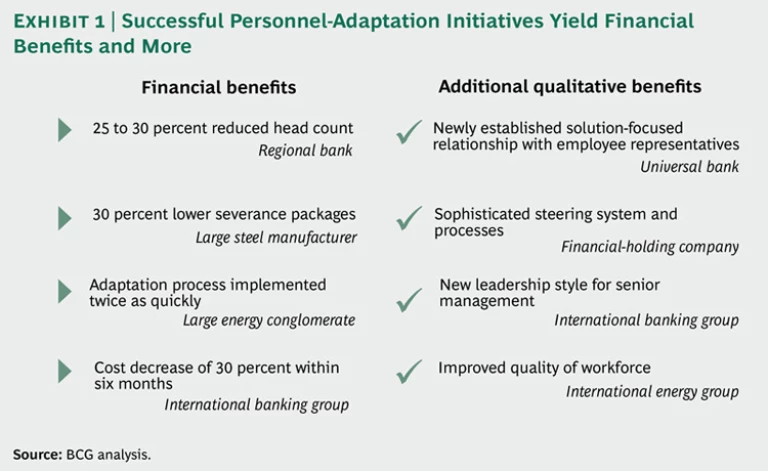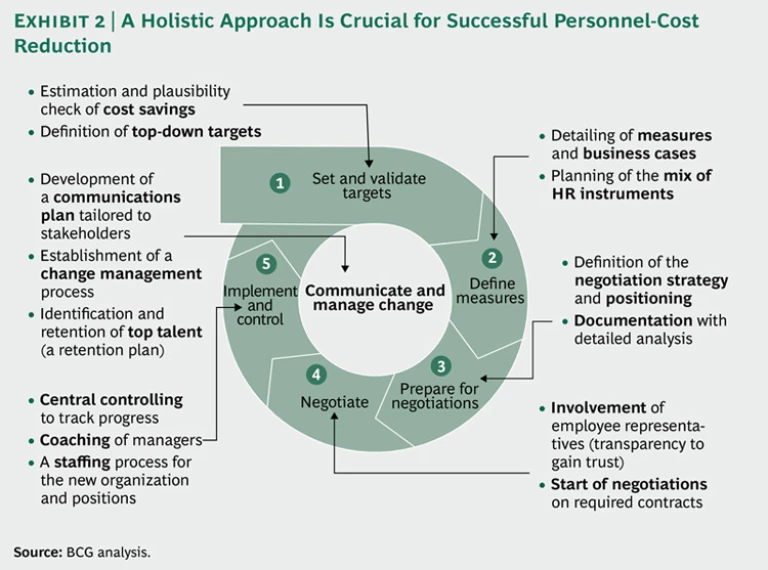Globalization and the worldwide financial crisis are just two of the economic pressures that have fueled increasingly fierce competition, particularly in developed countries, and have thus driven down prices and revenues. Cost pressures aimed at maintaining profitability are now the new reality in many industries, and organizations must seek long-term ways to reduce costs in a flexible and sustainable manner.
The largest cost in many industries is personnel. And in many industries, personnel challenges arise along two disparate dimensions: on the one hand, there is a need for personnel cost reduction in areas where employee numbers or pay scales are too high; on the other hand, skills and capacity gaps require hiring new people and developing sophisticated talent-management and talent-retention capabilities.
The management and maintenance of these divergent needs is a challenge. Many companies in the developed world have recognized the challenge and taken first measures by putting in place an “elastic” workforce over the past decade. They have increased the agility of their existing workforce by hiring temporary workers, balancing workloads using offshore locations, and outsourcing work.
But that is not enough. More changes are needed.
Internalize the Continual Need for Personnel Adaptation
Companies must not only ensure sustainable cost reduction but also modify the way they manage change. They need personnel adaptation strategies that encompass personnel cost reduction as well as talent retention and capability development. All of this must be managed in an environment of high uncertainty, which requires companies to remain flexible and to avoid being locked in by long-lasting agreements or guarantees.
The existing workforces of many companies are often undermanaged; the tendency to view the workforce as one homogeneous group has resulted in an upward pressure on numbers and pay rates.
The Boston Consulting Group has worked closely with clients that are confronting personnel adaptation issues, and we have found that the problems often include complex and noncompetitive tariff structures, patchy talent programs, biased personnel-reduction programs, and the failure of line management to perform its required tasks.
Another shortcoming can be insufficient implementation and communication of adaptation measures—when senior leaders fail to manage and communicate change, opportunities to realize savings and to motivate the remaining workforce can be missed.
Most companies also suffer from limited HR instruments and, more importantly, from the lack of a clear overall HR strategy, the absence of which allows fragmented historical practices and processes to persist.
Companies must at the same time retain critical know-how as well as find and develop new talents and skills—a particular challenge for those in countries with aging societies.
Most companies are now finding themselves both reducing and recruiting personnel at the same time in order to deal with the competing needs of different regions and business units. The concurrent needs of reducing and retaining require organizations to continually adjust their workforces to deal with the new reality.
To make such adjustments, companies require a clear picture of current and future needs across regions, countries, locations, business segments, and skill clusters. That picture should reflect the company’s overall strategy and be considered in step with strategic success factors. This should be the basis for appropriate stakeholder management and people processes.
Adopt Six Success Factors for Personnel Adaptation Initiatives
BCG regularly advises organizations on complex personnel-adaptation initiatives and has identified six key factors that are characteristic of successful projects and that will ensure a flexible and sustainable personnel-adaptation strategy. Some of these factors seem simple and obvious; nonetheless, the “devil is in the details” of their daily application. Further, companies should be aware that the complexity of a personnel adaptation implementation will increase with the size of an organization and the number of stakeholders involved. They should also beware of adopting narrow or short-term practices that can ultimately be ineffective or even harmful. Thus, the following six success factors should form the basis of the personnel adaptation initiative and be adjusted according to the situation at hand.
Managing the effort from start to finish must be a priority for senior executives. Any personnel adaptation initiative must be given a clear priority. Furthermore, all responsible senior executives of the company must support a chosen approach and keep their focus on it throughout the implementation phase.
Ensure “one-stop” competence. One central office should be established and charged with full ownership in terms of conception, development, communication, and process steering, including provision of guidelines and binding rules that must be followed by all individuals involved.
Focus on the underlying issues, not just on symptoms. An organization should build processes and incentives that both address the root causes of its personnel imbalances and allow sufficient flexibility for problem solving along the way, using state-of-the-art tools to ensure transparency on all key issues.
Involve the organization’s employee representatives. An organization should prioritize transparency and enter into target-focused and cooperative negotiations with employee representatives.
Make it happen. The start-to-finish project plan should include a rigorous approach to communication and implementation and establish clear lines of responsibility.
Review your success. State-of-the-art processes and analytical tools should be used to capture detailed, real-time data. The project plan should also allow for regular reviews in which potential issues are considered.
Prepare for Common Personnel-Adaptation Challenges
A personnel adaptation initiative is a critical and far-reaching undertaking that presents a number of common execution challenges. Companies need to be cognizant of the risks.
One of the most dangerous risks in a personnel adaptation initiative is the loss of senior buy-in—the risk that, once the business planning and negotiations are completed, the project will no longer be a top priority for senior management. But once a personnel adaptation strategy has been crafted, it is important that senior management sees the process through and is not tempted to revise the plan or the underlying principles when the first signs of resistance appear in the organization or when competing issues arise.
A diminishing senior presence and waning compliance with general guidelines during a project make it difficult for managers further down the chain to successfully negotiate with employee representatives or to fully implement the agreed-upon adaptation measures. In such a scenario, the full benefit of the implementation can be lost; an added disadvantage is the demotivation of the remaining workforce and managers.
To promote sustained senior buy-in, it is essential that real-time reporting continues throughout the implementation and that senior management is willing to “walk the talk” and ensure that the implementation is completed.
An effective way to ensure a sustainable implementation that endures beyond the adaptation is to appoint senior project managers. These individuals will take the lead in monitoring and challenging the implementation in business units, using world-class tools, and will frequently report to the management board, thus ensuring “one truth” with regard to implementation status.
Companies also need to ensure that they have in place HR instruments and processes that support the underlying principles of the personnel adaptation. Any existing approaches should be carefully reviewed and adapted. Companies must assess not only the instruments themselves (such as early retirement, termination agreements, qualification offers, “voluntary leaver” programs, and enforced redundancies) but also the processes behind the instruments, including how to address affected employees and how to perform reporting and follow-up processes.
In designing new HR instruments and processes, companies must consider both the current situation within the organization as well as the strategy and targets that the organization wants to achieve. (See “What Does It Mean for an HR Department?”) Failure to do so could diminish acceptance of the personnel changes within the organization and potentially lead to higher costs.
By thoroughly analyzing current workforce and contract structures, using state-of-the-art analytical techniques, companies can develop HR processes and instruments that are designed specifically for the affected employees and are adequate to deal with the planned changes. Having the right instruments in place will save time, reduce costs, and support a successful personnel-adaptation implementation. Careful planning will also help companies meet their social responsibilities and limit any potential damage to the companies’ reputation.
However, in our experience, success is determined more by the orchestration of the set of HR instruments and less by the specific design of an individual instrument itself. This orchestration includes relevant instruments for the remaining workforce, in particular retention instruments. These are less about monetary incentives for top performers or key talents and more about appreciation. Providing either further opportunities (in the form of new responsibilities or development programs) or positive feedback from line managers can have stronger and longer-lasting effects than a single financial offering.
Executing and implementing a personnel adaptation initiative requires teamwork beyond HR. It is crucial that all the stakeholders are aligned and working together. BCG has noted, in fact, that many successful and lasting adaptations have been made when a company is in “crisis mode” and management is fully aligned across divisions.
A personnel adaptation initiative often represents a major change for an organization—and these projects can represent a chance for a fresh start. For the employees remaining with an organization, the initiative is a time to introduce new structures and work processes. Efficient and effective execution of a personnel adaptation effort should include a strategic approach to ensure the sustainability of the new organization. One important element is an adapted talent-management approach that will engage top performers and secure key talent.
The effects of a successfully implemented adaptation process—including successful development, management, and retention of talent, as well as cost reduction—can sometimes become visible only after a certain period of time. However, BCG has found that the benefits of a successful adaptation initiative are more than just financial; organizations usually experience a number of positive secondary results. (See Exhibit 1.)
BCG has also found that in addressing all of these challenges—particularly those in the sensitive area of personnel cost reduction—it is crucial to follow a holistic approach that encompasses business model adaptations, negotiations, implementation, and communication.
Embrace a Holistic Approach to Personnel Cost Reduction
BCG has established a standard holistic process, relevant across industries and regions, to tackle any personnel reorganization, including those whose primary focus is personnel cost reduction.
This process comprises six main steps that need to be thoroughly planned and carefully executed. (See Exhibit 2.) Five steps should occur sequentially; the sixth measure should be considered and implemented throughout the process.
Set and validate targets. Clear top-down reduction targets and an easy-to-communicate rationale are the basis for any large change project. These targets—and the reasoning behind them—should be systematically communicated throughout an organization, starting with the senior executives and cascading through the organization. But the organization also needs to complete a bottom-up analysis that determines the amount, speed, and location of the changes that the organization wants to achieve.
Define personnel-cost-reduction measures. The personnel-cost-reduction measures are the foundation for any business case. The planned changes and the reasoning behind them need to be explained, quantified, and documented in careful detail. All nonnegotiable factors, such as legal constraints, need to be taken into account, as do detailed cost positions. These measures will be a key part of any necessary negotiations and will assist with successful implementation.
Prepare for negotiations with employee representatives. In many countries, restructuring a workforce involves compulsory negotiation with employee representatives (such as works councils or trade unions). Companies should prepare a negotiation strategy aimed at maintaining a focus on resolving the key issues and keeping the negotiation process on track.
Negotiate with employee representatives. In addition to a strong understanding of the relevant labor laws and a clear negotiation strategy, companies should bring sophisticated project-management skills to the table to ensure a successful outcome to the negotiations. Those actively involved in the negotiations should have clearly defined roles, the agility to make quick decisions, and a good understanding of the possible outcomes.
Implement and control the personnel-cost-reduction measures. Following a successful negotiation, companies need to give their full attention to the implementation and ensure that the process is thorough and complete to achieve sustainable cost reduction. The process should be centrally monitored and supported with training and coaching measures. This will enable the organization to realize the benefits of the restructuring initiative and to balance competing interests.
Communicate and manage change. Any project that leads to large-scale personnel adaptation must be supported by a comprehensive and tailored communication and change-management plan. This step, unlike the first five, should not occur in sequence, at the end of the process; rather, it should be implemented throughout the holistic approach.
Communication and change management are often recognized as vital parts of a personnel adaptation process, but in many cases they are insufficiently executed. The negative effects of insufficient communication and change-management actions can be tremendous and long-lasting, so organizations should put a detailed plan in place and engage key stakeholders from the start.
The need for cost reduction and personnel adaptation will remain a key strategic challenge for companies in developed markets. In regions such as Europe, companies face the extra challenges of comprehensive labor regulations and a long history of employee participation.
Difficulties aside, personnel adaptation processes are just one part of an overall change-management effort that can bring plenty of positive opportunities, including workforce quality enhancement, leadership improvement, talent retention, sophisticated steering processes, and better working relationships with stakeholders. Companies that successfully navigate the key issues will find not only an enhanced ability to compete but also the opportunity to establish a progressive work environment and a new team spirit for management and employees.
Now is the time to adjust workforces for the new reality.











